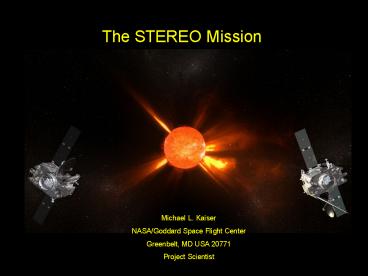The STEREO Mission - PowerPoint PPT Presentation
Title:
The STEREO Mission
Description:
Characterize the propagation of CMEs through the heliosphere ... IMPACT: 1 min aves of B, 1 min aves solar wind moments and selected SEP fluxes ... – PowerPoint PPT presentation
Number of Views:38
Avg rating:3.0/5.0
Title: The STEREO Mission
1
The STEREO Mission
Michael L. Kaiser NASA/Goddard Space Flight
Center Greenbelt, MD USA 20771 Project Scientist
2
Science Objectives
- Understand the causes and mechanisms of Coronal
Mass Ejection (CME) initiation - Characterize the propagation of CMEs through the
heliosphere - Discover the mechanisms and sites of energetic
particle acceleration in the low corona and the
interplanetary medium - Develop a 3D time-dependent model of the magnetic
topology, temperature, density, and velocity
structure of the ambient solar wind
3
Level 1 Science Requirements
- NOTES
- The four science objectives are split into 17
Level 1 measurement requirements - Some measurements (C, D, E) are defined for three
heliospheric regions, low and upper corona, and
interplanetary medium (IPM)
4
Level 1 Science Requirements (2)
5
STEREO INSTRUMENTS
- SECCHI- Remote Sensing Package that will track
Coronal Mass Ejections (CMEs) from the Sun to the
Earth. PI Russ Howard, Naval Research Lab - Two White Light Coronagraphs (COR1,COR2)- COR1
explores 1.4 4 Rsun. COR2 explores 2 15 Rsun - Extreme Ultra Violet Imager (EUVI)- Observes
chromosphere and inner corona - Heliospheric Imager (HI1, HI2)- Observes Coronal
Mass Ejections from the Sun to the Earth (12
300 Rsun) - IMPACT- will sample the 3-D distribution of solar
wind plasma electrons, the characteristics of the
energetic particle ions and electrons, and the
local magnetic field. PI Janet Luhmann,
UCBerkeley - Solar Wind Experiment (SWEA)-Measures 0-3 keV
electrons with wide angle coverage - Suprathermal Electron Telescope (STE)-Measures
electrons from 2-100 keV with wide angle coverage - Magnetometer Experiment (MAG)-Measures the vector
magnetic field at 65,536 nT and 500 nT ranges - Solar Energetic Particle Experiment (SEP) Suite
- Measures electrons from 0.02-6 MeV
- Measures protons from 0.02 100 MeV
- Measures helium ions from 0.03 100 MeV/nucleon
- Measures heavier ions form 0.03 40 MeV/nucleon
- PLASTIC- will provide the plasma characteristics
of protons, alpha particles, and heavy ion.
Provide composition measurements of heavy ions
and characterizes the CME plasma PI Toni
Galvin, UNH - SWAVES- in-situ as well as remote sensing
instrument. Tracks CME Driven Shocks from the
Corona to the Earth. PI J-L Bougeret, Paris
Observatory
6
STEREO-B (BEHIND) OBSERVATORY
SECCHI Sun-Centered Imaging Package (SCIP)
Assy (COR-1, COR-2, EUVI, GT)
1.1m X 2.0 m X 1.2 m 610 kg 600 W (EOL)
PLASTIC Instrument
IMPACT SEP
Deployed SWAVES Electric Field Antenna (3 places)
SECCHI Heliospheric Imager (HI)
Deployed IMPACT Boom
IMPACT Magnetometer (MAG)
IMPACT Suprathermal Electron Detector (STE)
IMPACT Solar Wind Electron Analyzer (SWEA)
7
Mission Orbit
4 yr.
3 yr.
Ahead _at_ 22?/year
2 yr.
1 yr.
Sun
Sun
Earth
1yr.
Ahead
Behind _at_ -22?/year
Earth
2yr.
Behind
3 yr.
4 yr.
Heliocentric Inertial Coordinates (Ecliptic Plane
Projection)
Geocentric Solar Ecliptic Coordinates Fixed
Earth-Sun Line (Ecliptic Plane Projection)
8
STEREOGetting there is half the fun
9
http//stereo.gsfc.nasa.gov
10
http//stereo-ssc.nascom.nasa.gov
11
STEREO Space Weather Data Products
- Beacon (space weather) data available
immediately - SECCHI 7 256 X 256 images every hour
- IMPACT 1 min aves of B, 1 min aves solar wind
moments and selected SEP fluxes - PLASTIC 1 minute resolution selected moments
and fluxes - SWAVES 1 minute summaries of selected
frequencies - Highest resolution data available 24-48 hrs
- SECCHI 2048 X 2048 images
- IMPACT fluxes (10s sec), moments (few sec) and
B (lt1 sec) - PLASTIC fluxes and moments 1 min resolution
- SWAVES intensities from all frequencies (320)
every 15 sec - Other data products available TBD
- Key parameters
- Catalogs and event tables
- Movies
12
(No Transcript)
13
(No Transcript)
14
Current status
- Spacecraft finished vibration testing at APL
- Spacecraft arrived at Goddard last Wednesday
- Acoustic testing today
- Thermal vacuum testing, followed by EMC Dec-Feb
- Ship to Cape March
- Launch in either early or late May
15
Observatory Vibration Test
16
May, 2006
Produced by Johns-Hopkins Applied Physics
Laboratory
17
Launch 90 days ? Aug/Sept. 2005
Produced by NASA/Goddard Space Flight Center
18
(No Transcript)

